Digital Transformation is no longer optional – Eric Longo (August 2021)

Good morning/good afternoon everyone.
And thank you Dominik, and Monica, for inviting me to provide opening remarks for the CIDOC 2020 conference, which is a virtual conference, let’s not forget it!
It’s an honor to be with you today and I want to thank you for the opportunity to share my thoughts on digital transformation at such a critical time for the museum and cultural heritage sector.
I am Eric Longo, Executive Director of the Museum Computer Network (MCN)
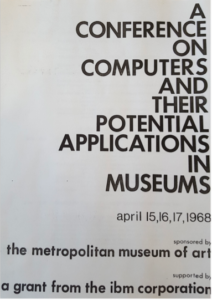
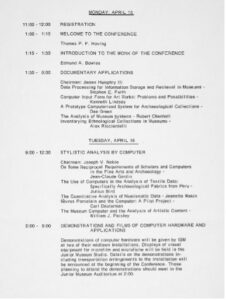
MCN was founded in New York City in 1967 as a professional membership association for museum professionals who work in or around tech and digital, nowadays referred to as the #musetech community. We offer our members a variety of programs, communities of practices, and networking opportunities, including our annual conference, which we’ve quite remarkably managed to keep going every year since 1968!
MCN’s mission is anchored on the professional development needs of museum professionals by providing a space for them to connect, advance the thinking around emerging technologies, and share new approaches to digital engagement in museums. And I’m sure our tag line – advancing digital transformation in museums – was not lost of you!

Since I believe there is a number of archivists among you today, you might be interested in learning more about MCN’s history by viewing our dynamic online timeline.
But more on MCN in a little bit.
It’s not an exaggeration to say that each one of us wherever we are around the globe has lived through one of the most challenging year in recent memory.
The COVID-19 pandemic has shaken us to our core. As a species, we don’t do very well with uncertainty. We don’t like it when things are unpredictable. We like to be in control, or at the very least believe that we are. And we prefer simple answers to difficult questions, because sound bites are well… simpler yes, but they can lull us in a false sense of safety, they’re reassuring somehow.
The term ‘digital transformation’ seems to have emerged in the early 2000s as businesses started to transition their operations to adapt to the internet (the early days of Web 1.0). By the late 2000s, digital transformation fast became another one of those overused buzz words that our overhyped, over mediated, entrepreneurship-obsessed society is so fond of concocting, joining the ranks of innovation, pivot, agile, synergy, viral, customer journey, KPIs and so many others among slogans devoid of substance.
So when asked what title I wanted to give to today’s address, considering the theme of the conference and the pandemic, my response could only be: digital transformation is no longer optional.
And yet, while digital transformation may indeed be overused, the concept is far from being vacuous as I’m sure you all know and as you’ll explore over the next few days of this event.
In the face of crisis, our innate reaction is to flee. Or to act fast, without thinking. Back in the spring, it seems museum directors around the world got the same instruction for their teams: drop what you do and get everything online right away.
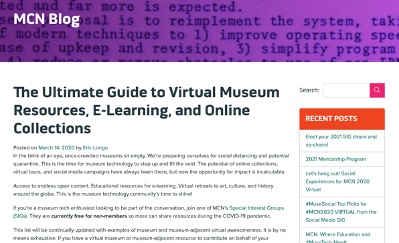
And so that’s what the vast majority of museums, large and small, did. With little or no forethought as to why this was necessary beyond the comfort of knowing that if your collection is online, well at least you did that. That’s useful. To a point. Perhaps.
In mid-March, MCN started an inventory of online collections, virtual tours, e-learning resources, all this online material suddenly offered by museums as if, somehow, doing so was going to address the inescapable reality that museums were ordered closed until further notice
This was useful perhaps, but reactive. Not responsive. Let’s be clear, what really….
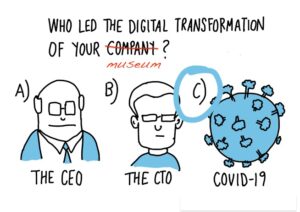
… led digital transformation this year was COVID, not museum directors.
It was a classic example of what happens when we react to a crisis without thinking.
Personally, I’ve learned from experience, that in times of crisis what I need is less distractions, less sound bites, less quick answers and more time to pause, to reflect, to go within. Because by doing so, I’m shown how to respond, and it’s often not what a prescribed reaction would provide.
So what I thought I would do today is stay clear from giving you ready-to-wear answers, a fix, the next 14 or 17 reasons for why your museum shld get on the digital bandwagon. I hope you won’t be disappointed if that’s what you expected but there’s plenty of material on this already out there.
No, what I invite you to do instead is to pause, reflect, listen. Develop the critical habit of asking better questions so that we can make sense of the input: what does this mean? How much of this change is temporary? How much of it is here to stay? And, forgive my pun, the wisdom to know the difference.

But joke aside, it’s time for us to stop looking for answers and time to ask questions. Time to understand. So we can better respond. Because understanding moves us forward. Understanding changes behavior. And it is each one of us individually who through changing our own behavior, change our environment: from our loved ones to friends to colleagues to organizations to the world.
It’s time for each of us to embody digital transformation by changing the ways in which we think, plan, collaborate, create, share, include, tell stories, and so on. It’s time to be digitally transformed.
We, not institutions, are the future of museums: we are the ones who ultimately drive digital change in museums, and this is true now more than ever.
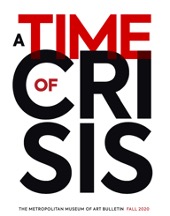
The crises of this year have undoubtedly altered how we see the world.
In a session entitled “Lessons from the Coronavirus: There Is No “Pivot” during MCN 2020 VIRTUAL recently – my colleagues Brad Dunn, Dana Allen-Greil and Susan Edwards – explained how the pandemic upended many museums’ business and engagement strategy for the year. It exposed the foundations underlying our efforts across digital, good and bad, and in many cases, it caught us flat-footed. Digital teams acted quickly to change their mandate entirely. The goal of digital engagement and marketing shifted from driving visitation to a physical building, a geographical location, to creating an equally compelling online museum experience. Digital teams had to figure out quickly how to engage audiences stuck at home with no chance to visit their institutions. As mentioned earlier, the call for change was quick, often seemed panicked or at least reactionary, and came from all leadership levels.
What do we do with change?
The cover of the current quarterly bulletin of the Met museum is appropriately titled in Russian avant guardesque typography: A Time of Crisis. It serves as both an acknowledgement of the times we’re going through, and as a brilliant demonstration of a thoughtful response: instead of featuring recent acquisitions, the Bulletin is itself a disruption, answering a different call: a collection of essays from various staff members sharing new perspectives — filtered through the lens of 2020 — on the museum and the collection. Because not doing this would have come across as tone deaf.
To help us understand what digital transformation means in the year of COVID, I thought it’d be useful to frame things in a larger context. So let’s dive in a bit deeper.
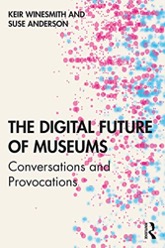
I’m big on context because I see life is shades of grey. Things are almost always nuanced and need to be considered within a certain context.
As disruptive the COVID-19 crisis is, it’s also happening at a time of profound systemic changes. And to help us understand the forces at work, I highly recommend this great book called The Digital Future of Museums, Conversations and Provocations by Keir Winesmith and Suse Anderson published by Routledge.
Specifically, I can’t recommend enough Suse’s first chapter that’s called “Some provocations on the digital future of museums”, in which she masterfully paints the dynamics at play in the larger world and how these forces are changing museums.
So you know, what follows is a very high level recap of some of the key elements of Suse’s demonstration but also a way to credit this important work.

As disruptive as COVID-19 is, it’s also happening at a time of profound systemic changes.
Acting like tectonic plates of sorts, these changes are the result of a confluence of dynamic forces interacting with each other in various interdependent complex systems.
Tensions within and between these systems trigger chaotic effects with knock-on global impacts. Among them: globalization and urbanization, demographic changes and generational shifts, social, economic and racial inequalities, climate change and migrations, jobs outsourcing, substantial technological developments. And in the past 30 years, the internet has left the world more connected, and the emergence of social media more interconnected.
The dynamics of collective attention are accelerating, fragmenting and hastening public discussion. As individuals, institutions and society, we are ill-equipped to deal with and make sense of such complexities.
So what does this mean for museums?
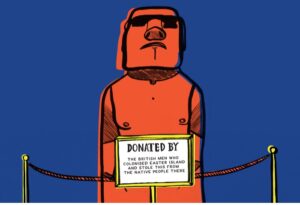

These transformations are causing tremendous challenges for epistemological institutions such as museums and cultural heritage sites, whose normal approaches to knowledge were informed by a sets of assumptions made in the 19th century…
In this new world, museums that were established on structures of colonial and patriarchal oppression are now being challenged from all sides: lack of pluralistic narratives in which younger generations fail to see themselves and their shared experiences reflected.
Social media gave people the ability to participate in online discourse, thereby bringing into question existing models of authorship and authority and allowing user-generated content now giving individual creators the ability to bypass traditional gatekeepers of knowledge and access, including the hold that museums had on narratives and voices.
This rapid change of our society is almost entirely driven by digital technology progress and is causing enormous stress of the very risk averse and static built in systems of oppression and inequality that museums are a part of.




It is too soon to adequately assess the impact of the pandemic on museums on top of these larger societal trends but generally speaking, museums that had already prioritized digital were much quicker to respond to closures – it didn’t necessarily solved the lack of visitor generated revenues but those were more prepared and positioned to lean on their mission and engage with digital audiences.
The economic and social consequences of the COVID-19 pandemic on the cultural sector however, have already shown to be devastating and are likely to be felt far into the future. 63% of cultural organizations in the United States expect the overall financial impact of the coronavirus on their organization to very to extremely severe. The data points featured on this slide are from July but the total economic impact on the sector is estimated to be about $6.7 billion and combined staff layoffs upwards of 62,000 workers.
The data points for the situation in Europe are mostly like quite different but will be felt in similar ways.
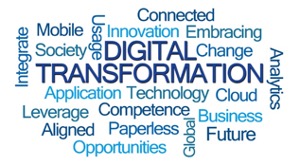 So what is digital transformation?
So what is digital transformation?
It’s not about digital or technology per se. Technology is a set of tools in the service of a museum’s mission.
Digital transformation on the other hand, is an organizational change that requires an institution to rethink its organizational structure, systems, processes, workflows and culture so that they’re aligned with not only new digital tools and platforms but also meet the expectations of digitally savvy visitors or guests. By the way, digital transformation also includes the ongoing, adaptive and often challenging process of managing through that change.
In simpler terms, digital transformation is about recognizing that digital technology has changed how we access and share information, how we connect with each others, and how we navigate and make sense of the world we live in. It has empowered us to have greater agency on our desires, decisions and thoughts. Not always in ethical ways, but that’s another conversation altogether.
Many museums have been actively engaged in this process of many years and were positioned to succeed in the quickly changing environment brought on by the COVID-19 closures and they stepped into action when it happened. In this sense, it was much less pivoting rather than building on top of groundwork that had been in the planning for years, utilizing existing collaborative structures and systems upon which we had long relied.
Still, too many museums, particularly smaller ones, still operate under traditional hierarchical structures and cultures whose time has long passed and therefore sorely fail their ability to deliver on their missions. Digital transformation is hard work. It requires a complete organizational commitment to rethink our work and how we work. But one thing the pandemic has made very clear to all of us is this work is no longer optional. Digital transformation is no longer optional.

Since I don’t directly work for a museum, I thought it would be of interest to share with you how MCN shifted to an all virtual model for this year’s annual conference, which ended two weeks ago.
Some of the lessons we learned through that process can serve as a metaphor for transposing for things virtually for museums and cultural heritage sites in general.
Accessibility + enhanced reach
No travel
Greater affordability

Without implying that virtual conferences could become the new normal, just as working from home may be the new normal, the most salient benefit afforded by a virtual conf model has already become apparent, and that is greater accessibility, in all of its forms.
We can’t expect users to spend 8 hours in front of a digital screen for anywhere from a couple of days to a week depending on events. Not to mention that almost everyone was now working from home, many juggling professional obligations with homeschooling duties, making the prospect of following a full conference program online totally daunting, if not a non-starter for many. Program schedules created for a physical event therefore had to be rearranged.
Other conf orgs repurposed their annual conference programs to accommodate attendees’ ongoing work schedules.
As the MCN conference program team began this process, it quickly became apparent that they were approaching the task in the same way that we would normally do for an in-person event. This realization made us aware of the need to develop the program from a user-centered perspective. We decided to design the conf schedule natively, for digital consumption, without the constraints of a standard 8 hour-day in which to fit a bunch of concurrent sessions into six or seven breakout rooms. We shifted the approach midway through the planning process, we thought as content as something to be snacked on throughout the day on-demand, thereby allowing users located in different time zones the ability to catch some, not all, live sessions when they are awake (all sessions were recorded)
We can’t talk about this without mentioning the ”i” word (another overused business jargon term). Innovation is an exploratory and reflective process that looks for possibilities and opportunities built around resilience and collaboration. The crisis brought on by the pandemic has shown that many museum professional associations as well as museums themselves were ill-prepared to withstand disruption of their business models on a scale of this magnitude. Conference organizers that adapted under pressure of the pandemic did so out of necessity, as a reaction. Museum associations and museums alike should embrace adopting an innovation mindset and foster a culture of innovation across their often-small organizations – it’s an iterative agile process that’s highly adaptable that helps to stay ahead of the curve and build resilience and organizational capacity so they can continue to support museums and museum professionals, especially as the sector will emerge and begin the process of reconstructing itself.
Virtual model benefits:
- Accessibility + enhanced reach:

Online accessibility: in-person events are inherently limited by space and time: they happen in a certain location, inside a venue with a certain number of meeting rooms, over a number of days with a set schedule in a specific time zone.
Conference organizers know the headaches of building a program schedule within these logistical constraints.
Such barriers don’t have to exist online: sessions can be scheduled throughout the day to take advantage of combined time zones allowing users to access content on-demand; users can surf between sessions without disrupting others; simultaneous chat channels can help filter questions and answers thereby allowing more attendees to participate; session recording is a common feature of most online platforms compared to the prohibitive cost of live streaming, making “the entire conference experience accessible” to all participants; and live captioning is an accessibility feature that benefits everyone, not just those with hearing impairments.
- No need to travel:

Attending professional in-person conferences has been a privilege afforded mostly to senior staff at top institutions. Without financial support from their institution, conference costs (registration + travel + hotel + incidentals) combined with time away from work have essentially prevented most museum workers from attending professional events. Budget cuts in museums as a result of the economic impact of the pandemic are only going to reinforce this problem. In addition, reduced air travel is also environmentally friendly and many organizations have been adopting environmental sustainability policies that encourage staff to minimize air travel, especially internationally.
- Greater affordability:
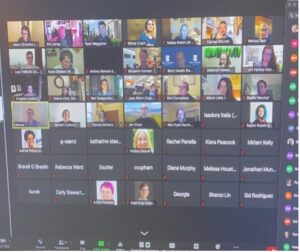
Online events are much cheaper to produce than in- person ones giving organizers the opportunity to offer significantly reduced registration fees. As online events are cheaper to attend, they are also more inclusive and more accessible to many, especially for small institutions that may not have the budget or staff size to send team members off-site. With online events, museum associations now have the opportunity to greatly increase their reach beyond their former limited audience. Associations whose missions are a specific museum profession or practice area, such as curatorial, directors, or digital technology, we can now reach beyond their borders and grow global membership.
These upsides also apply to museums as well.
- Large annual conferences may be over for a while to come.
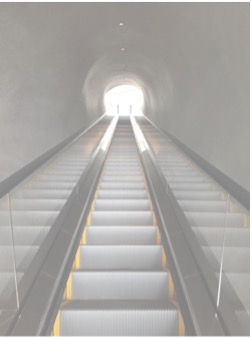
- Certain experiences are easier to transpose virtually than others.
- It’s never a replacement for IRL experiences but it works
Given the unknowable trajectory of the pandemic and the unprecedented nature of the current circumstances, predicting, with any degree of accuracy, where the dust will settle in what many call a “post-COVID world” is incredibly challenging. That said, the long-term damage that the pandemic has already inflicted on the economy can help us make a few key assumptions from which we can infer a few possible outcomes.
It helps to remember that there’s always light at the end of the tunnel. Because of the opportunities afforded by digital technology, museum professional associations have the ability to support to the sector in transitioning to the new operating paradigm.
Taken together, these trends point to long-term global effects over the next 18 to 30 months and will likely prevent professional events and conferences from taking place altogether in spite of the desire among many to hold face-to-face meetings with clients and colleagues.
The days of large annual conferences may be over for a while to come. Travel restrictions have caused air travel passenger traffic to plummet by 95 percent by April of 2020 and experts predict that the global business travel market, including the hospitality industry, may lose 810.7 billion U.S. dollars in revenue in 2020, and may never fully recover from before pandemic levels. We may see more frequent, regional, day-long single events or mini conferences taking place to serve local members and allow them to reconnect and network while professional development opportunities will be available online.
Certain experiences are easier to shift to a virtual model than others
And, yes. Virtual is never a replacement for IRL experiences but it works and in fact the benefits can outweigh the downsizes.
“In previous times of crisis, the Museum served as a place of refuge for New Yorkers seeking solace or inspiration. Our closure challenged us to reach out to a global audience, grounded at home, by broadcasting more of our offerings online.
In the face of adversity, these “restrictions” stimulated the creativity of our staff and fostered a sense of shared experience that will continue to push us forward to explore the digital realm and extend our connections with followers worldwide.”
Max Hollein, Director, The Metropolitan Museum of Art
In parting, I thought I’d leave you with this quote from Max Hollein, the director of the Met.
Remember that digital transformation is about people, it’s about you and me doing the best they can in their respective roles and organizations to embodying a new way of thinking, a new way to inquire, a new way to work and collaborate. And you’re already doing it.

thank you!
Bio: Eric Longo serves as Executive Director for Museum Computer Network (https://mcn.edu) whose mission is to grow the digital capacity of museum professionals by connecting them to ideas, information, opportunities, proven practices, and each other. MCN tweets at @MuseumCN